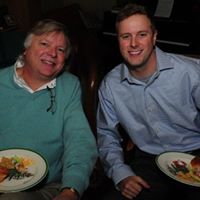Matthew R Grant
age ~40
from Brooklyn, NY
- Also known as:
-
- Matt Grant
Matthew Grant Phones & Addresses
- Brooklyn, NY
- Astoria, NY
- Springfield, IL
- Saint Louis, MO
- 2894 David Ave, San Jose, CA 95128 • 4083741929
- Bronx, NY
Isbn (Books And Publications)








Medicine Doctors

Matthew H Grant
view sourceSpecialties:
Internal Medicine
Infectious Disease
Infectious Disease
Education:
Upstate Medical University Physical Medicine and Rehabilitation (2006)
Us Patents
-
High Efficiency Power Supply For Led Lighting Applications
view source -
US Patent:7265504, Sep 4, 2007
-
Filed:Jun 8, 2006
-
Appl. No.:11/450232
-
Inventors:Matthew Alan Grant - Palo Alto CA, US
-
Assignee:Semtech Corporation - Camarilla CA
-
International Classification:G05F 1/00
-
US Classification:315308, 315224
-
Abstract:A power supply for plural loads coupled in parallel comprises a voltage regulator, a plurality of current regulators, and an error control circuit. The voltage regulator provides a common output voltage to the plural loads. The voltage regulator comprises a sensor circuit providing a voltage sense signal corresponding to the output voltage, which provides feedback to regulate the output voltage at a selected level. The plurality of current regulators are coupled to respective ones of the plural loads. Each of the plurality of current regulators regulates current drawn by respective ones of the plural loads to within a desired regulation range. The plurality of current regulators each further provide a respective error signal corresponding to an ability to remain within the desired regulation range. The error control circuit is operatively coupled to the voltage regulator and to the plurality of current regulators. The error control circuit receives the error signals from the plurality of current regulators and provides a common error signal to the voltage regulator.
-
Constant Current And Voltage Controller In A Four-Pin Package With Dual-Use Pin
view source -
US Patent:7522431, Apr 21, 2009
-
Filed:Jul 31, 2007
-
Appl. No.:11/888599
-
Inventors:Steven Huynh - Sunnyvale CA, US
Matthew Grant - Palo Alto CA, US
David Kunst - Cupertino CA, US
Zhibo Tao - San Jose CA, US -
Assignee:Active-Semi International, Inc.
-
International Classification:H02M 3/335
-
US Classification:363 2112, 363 2105, 363 2113, 363 2115, 363 2116
-
Abstract:A comparing circuit and a control loop are used to maintain the peak level of current flowing through an inductor of a flyback converter. An inductor switch control signal controls an inductor switch through which the inductor current flows. The inductor current increases at a ramp-up rate during a ramp time and stops increasing at the end of the ramp time. The comparing circuit generates a timing signal that indicates a target time at which the inductor current would reach a predetermined current limit if the inductor current continued to increase at the ramp-up rate. The control loop then receives the timing signal and compares the target time to the end of the ramp time. The pulse width of the inductor switch control signal is increased when the target time occurs after the end of the ramp time. Adjusting the pulse width controls the peak of the inductor current.
-
Adjusting Inductor Switching Frequency To Compensate For Inductance That Deviates From A Stated Magnitude In Order To Maintain Constant Output Current From A Primary-Side Power Converter
view source -
US Patent:7667987, Feb 23, 2010
-
Filed:Jul 26, 2007
-
Appl. No.:11/881666
-
Inventors:Steven Huynh - Sunnyvale CA, US
Matthew Grant - Palo Alto CA, US
David Kunst - Cupertino CA, US -
Assignee:Active-Semi, Inc.
-
International Classification:H02M 3/335
-
US Classification:363 2112, 363 2101, 363 2113, 363 2118
-
Abstract:A comparing circuit and a control loop are used to maintain the peak level of current flowing through an inductor of a flyback converter. An inductor switch control signal controls a switch through which the inductor current flows. The inductor current increases at a ramp-up rate during a ramp time and stops increasing at the end of the ramp time. The comparing circuit generates a timing signal that indicates a target time at which the inductor current would reach a predetermined current limit if the inductor current continued to increase at the ramp-up rate. The control loop then receives the timing signal and compares the target time to the end of the ramp time. The pulse width of the inductor switch control signal is increased when the target time occurs after the end of the ramp time. Adjusting the frequency and pulse width controls the peak of the inductor current.
-
Compensating For Base Current In A Primary Side Power Converter That Uses An Npn Bipolar Transistor
view source -
US Patent:7679936, Mar 16, 2010
-
Filed:Aug 14, 2007
-
Appl. No.:11/893231
-
Inventors:Steven Huynh - Sunnyvale CA, US
Matthew Grant - Palo Alto CA, US
David Kunst - Cupertino CA, US
Zhibo Tao - San Jose CA, US -
Assignee:Active-Semi, Inc.
-
International Classification:H02M 3/335
-
US Classification:363 16, 363 2102, 363 2112, 363 24
-
Abstract:A comparing circuit and a control loop are used to maintain the peak level of current flowing through an inductor of a flyback converter. An inductor switch control signal controls a switch through which the inductor current flows. The inductor current increases at a ramp-up rate during a ramp time and stops increasing at the end of the ramp time. The comparing circuit generates a timing signal that indicates a target time at which the inductor current would reach a predetermined current limit if the inductor current continued to increase at the ramp-up rate. The control loop then receives the timing signal and compares the target time to the end of the ramp time. The pulse width of the inductor switch control signal is increased when the target time occurs after the end of the ramp time. Adjusting the frequency and pulse width controls the peak of the inductor current.
-
Compensating For Inductance Variation In A Power Converter Using A Dual-Purpose Feedback Pin
view source -
US Patent:7697308, Apr 13, 2010
-
Filed:Dec 3, 2008
-
Appl. No.:12/315418
-
Inventors:Steven Huynh - Sunnyvale CA, US
Matthew Grant - Palo Alto CA, US
David Kunst - Cupertino CA, US
Zhibo Tao - San Jose CA, US -
Assignee:Active-Semi, Inc.
-
International Classification:H02M 3/335
-
US Classification:363 2116, 363 2104, 363 2105, 363 2113, 323300
-
Abstract:A comparing circuit and a control loop are used to maintain the peak level of current flowing through an inductor of a flyback converter. An inductor switch control signal controls an inductor switch through which the inductor current flows. The inductor current increases at a ramp-up rate during a ramp time and stops increasing at the end of the ramp time. The comparing circuit generates a timing signal that indicates a target time at which the inductor current would reach a predetermined current limit if the inductor current continued to increase at the ramp-up rate. The control loop then receives the timing signal and compares the target time to the end of the ramp time. The pulse width of the inductor switch control signal is increased when the target time occurs after the end of the ramp time. Adjusting the pulse width controls the peak of the inductor current.
-
Flyback Constant Voltage Converter Having Both A Pwfm Mode And A Pwm Mode
view source -
US Patent:7746673, Jun 29, 2010
-
Filed:May 10, 2008
-
Appl. No.:12/152035
-
Inventors:Matthew A. Grant - Palo Alto CA, US
Zhibo Tao - San Jose CA, US -
Assignee:Active-Semi, Inc.
-
International Classification:H02M 3/335
-
US Classification:363 2118, 363 2112
-
Abstract:A flyback AC/DC switching converter has a constant voltage (CV) mode. The CV mode has sub-modes. In one sub-mode (“mid output power sub-mode”), the output voltage (VOUT) of the converter is regulated using both pulse width modulation and pulse frequency modulation. Both types of modulation are used simultaneously. In a second sub-mode (“low output power sub-mode”), VOUT is regulated using pulse width modulation, but the converter switching frequency is fixed at a first frequency. By setting the first frequency at a frequency above the frequency limit of human hearing, an undesirable audible transformer humming that might otherwise occur is avoided. In some embodiments, the converter has a third sub-mode (“high output power sub-mode”), in which pulse width modulation is used but the switching frequency is fixed at a second frequency. By proper setting of the second frequency, undesirable EMI radiation and other problems that might otherwise occur are avoided.
-
Power Converters With Switched Capacitor Buck/Boost
view source -
US Patent:7795761, Sep 14, 2010
-
Filed:Dec 19, 2008
-
Appl. No.:12/317223
-
Inventors:Steven Huynh - Fremont CA, US
Matthew A. Grant - Palo Alto CA, US
Lin Chen - Mountain View CA, US -
Assignee:Active-Semi, Inc.
-
International Classification:H01H 9/54
-
US Classification:307140
-
Abstract:A power converter having a switched capacitor buck/boost operation has first and second switches coupled to a first switching node, third and fourth switches coupled to a second switching node, a capacitor coupled between the first and second switching nodes, and an inductor coupled to the first switching node. A switch controller controls the switches to operate in voltage step-down mode and voltage step-up mode depending on a difference between converter output voltage VOUT and converter input voltage VIN. In a buck-optimized topology operating in a step-down mode, an output current flowing through the first switching node flows through only one switch at a given time. In a boost-optimized topology operating in a step-up mode, an output current flowing through the first switching node flows through only one switch at a given time. As a result, a more compact and efficient power converter may be realized at lower cost.
-
Compensating For Cord Resistance To Maintain Constant Voltage At The End Of A Power Converter Cord
view source -
US Patent:7869229, Jan 11, 2011
-
Filed:Aug 28, 2007
-
Appl. No.:11/897131
-
Inventors:Steven Huynh - Sunnyvale CA, US
Matthew Grant - Palo Alto CA, US
David Kunst - Cupertino CA, US
Zhibo Tao - San Jose CA, US -
Assignee:Active-Semi, Inc.
-
International Classification:H02M 3/335
-
US Classification:363 2101, 363 2104, 363 2112, 34063612
-
Abstract:A cord correction circuit in a primary-side-controlled flyback converter compensates for the loss of output voltage caused by the resistance of the charger cord. In one embodiment, a correction voltage is subtracted from a feedback voltage received from a primary-side auxiliary inductor. A pre-amplifier then compares a reference voltage to the corrected feedback voltage. In another embodiment, the correction voltage is summed with the reference voltage, and the pre-amplifier compares the feedback voltage to the corrected reference voltage. The difference between the voltages on the input leads of the pre-amplifier is used to increase the output voltage to compensate for the voltage lost through the charger cord. The flyback converter also has a comparing circuit and a control loop that maintain the peak level of current flowing through the primary inductor of the converter. Adjusting the frequency and pulse width of an inductor switch signal controls the converter output current.
Name / Title
Company / Classification
Phones & Addresses
President
Grant Gutter Co
Gutters & Downspouts. Gutter Cleaning
Gutters & Downspouts. Gutter Cleaning
1220 O'day Rd, Saint Louis, MO 63119
3149622200
3149622200
Sales Executive
Risk Management Solutions Inc
Computer Programming Services
Computer Programming Services
7015 Gateway Blvd, Newark, CA 94560
Attorney
Arnold & Porter Llp
Legal Services
Legal Services
399 Park Avenue, New York, NY 10022
President
Grant Gutter Co
Gutters & Downspouts · Gutter Cleaning
Gutters & Downspouts · Gutter Cleaning
1220 O'day Rd, Saint Louis, MO 63119
3149622200
3149622200
NORTHSTAR PROPERTY GROUP LLC
MATTHEW J. GRANT, D.C., INC
Vehicle Records
-
Matthew Grant
view source -
Address:1625 Mason Knl Rd, Saint Louis, MO 63131
-
VIN:1GKFK63887J289310
-
Make:GMC
-
Model:YUKON
-
Year:2007
Resumes

Matthew Grant Astoria, NY
view sourceWork:
Coffee Bean & Tea Leaf
Dec 2012 to 2000
Shift Manager Starbucks
New York, NY
Jan 2010 to Nov 2012
Assistant Store Manager Kohl's
Dayton, OH
Jul 2008 to Oct 2009
Sales Associate Compunet Clinical Laboratories
Dayton, OH
Aug 2004 to Jul 2008
Tech Aide
Dec 2012 to 2000
Shift Manager Starbucks
New York, NY
Jan 2010 to Nov 2012
Assistant Store Manager Kohl's
Dayton, OH
Jul 2008 to Oct 2009
Sales Associate Compunet Clinical Laboratories
Dayton, OH
Aug 2004 to Jul 2008
Tech Aide
Education:
Wright State University
Dayton, OH
May 2009
Bachelor of Arts in English Literature Clark State College
Springfield, OH
May 2006
Associate of Arts
Dayton, OH
May 2009
Bachelor of Arts in English Literature Clark State College
Springfield, OH
May 2006
Associate of Arts
Lawyers & Attorneys

Matthew R. Grant - Lawyer
view sourceOffice:
Husch Blackwell LLP
Phone:
3144801914 (Phone), 3144801505 (Fax)
Specialties:
Food & Agribusiness
Seed Industry & Stewardship
Business Litigation
Toxic Tort
Intellectual Property
Intellectual Property Litigation
Product Liability
Seed Industry & Stewardship
Business Litigation
Toxic Tort
Intellectual Property
Intellectual Property Litigation
Product Liability
ISLN:
915373749
Admitted:
2000, Missouri
2001, Illinois
2000, U.S. District Court, Eastern District of Missouri
2002, U.S. District Court, Central District of Illinois
2002, U.S. District Court, Southern District of Illinois
2001, Illinois
2000, U.S. District Court, Eastern District of Missouri
2002, U.S. District Court, Central District of Illinois
2002, U.S. District Court, Southern District of Illinois
University:
Truman State University, B.A., Business Administration, 1997
Law School:
University of Missouri - Columbia School of Law, J.D., 2000 Journal of Dispute Resolution
Links:
Site
Biography:
Matt has extensive experience in a variety of legal issues impacting members of the food and agribusiness industry. His practice has included advising clients on matters such as crop seed bag labeling...

Matthew Richard Grant, Saint Louis MO - Lawyer
view sourceAddress:
Husch Blackwell LLP
190 Carondelet Plz Ste 600, Saint Louis, MO 63105
3144801914 (Office), 3144801505 (Fax)
190 Carondelet Plz Ste 600, Saint Louis, MO 63105
3144801914 (Office), 3144801505 (Fax)
Licenses:
Missouri - Good Standing, Active 2000
Specialties:
Intellectual Property - 34%
Litigation - 33%
Personal Injury - 33%
Litigation - 33%
Personal Injury - 33%

Matthew David Grant, New York NY - Lawyer
view sourceAddress:
Arnold & Porter LLP
399 Park Avenue, New York, NY 10022
2127151015 (Office), 2027151399 (Fax)
399 Park Avenue, New York, NY 10022
2127151015 (Office), 2027151399 (Fax)
Licenses:
New York - Currently registered 2003
Education:
Villanova University School of Law
Degree - JD - Juris Doctor - Law
Graduated - 2002
University of Richmond
Degree - BA - Bachelor of Arts
Graduated - 1998
Degree - JD - Juris Doctor - Law
Graduated - 2002
University of Richmond
Degree - BA - Bachelor of Arts
Graduated - 1998
Specialties:
Litigation - 20%
Insurance - 20%
Real Estate - 20%
Entertainment - 20%
Commercial - 20%
Insurance - 20%
Real Estate - 20%
Entertainment - 20%
Commercial - 20%

Matthew Michael Grant - Lawyer
view sourceLicenses:
New York - Currently registered 2012
Education:
New York Law School

Matthew Grant - Lawyer
view sourceOffice:
Husch Blackwell LLP
Specialties:
Business Litigation
Business and Corporations - Copyright
Food & Agribusiness
Intellectual Property
Intellectual Property Litigation
Patents
Precision Agriculture
Product Liability
Toxic Tort
Trademark
Unmanned Aircraft Systems
Business and Corporations - Copyright
Food & Agribusiness
Intellectual Property
Intellectual Property Litigation
Patents
Precision Agriculture
Product Liability
Toxic Tort
Trademark
Unmanned Aircraft Systems
ISLN:
915373749
Admitted:
2000
University:
Truman State University, B.A., 1997
Law School:
University of Missouri - Columbia School of Law, J.D., 2000

Matthew Grant - Lawyer
view sourceAddress:
The Plaza In Clayton Office Tower
Phone:
3144801914 (Phone), 3144801505 (Fax)
Work:
Husch, Blackwell, Sanders, Welsh & Katz LLP
Experience:
25 years
Specialties:
Business Law
Personal Injury
Products Liability
Business Litigation
Intellectual Property
Products Liability & Toxic Tort
Personal Injury
Products Liability
Business Litigation
Intellectual Property
Products Liability & Toxic Tort
Jurisdiction:
Illinois (2001)
Illinois 2001
Missouri (2000)
Missouri 2000
Illinois 2001
Missouri (2000)
Missouri 2000
Law School:
University of Missouri
Education:
University of Missouri, JD
Truman State University, BA
Truman State University, BA
Links:
Website
License Records
Matthew Douglas Grant Md
License #:
29496 - Active
Category:
Medicine
Issued Date:
Aug 11, 2016
Effective Date:
Aug 11, 2016
Expiration Date:
Oct 1, 2018
Type:
Physician
Flickr
Plaxo

Matthew Grant
view sourceEngineer at GV Grant & Associates

Matthew Grant
view sourceMason/Framing Supervisor at Us Guys Builders LLC
Myspace
Youtube

Matthew Bossmann Grant
view source
Matthew Destrogranty Grant
view source
Matthew Charles Grant
view source
Matthew Oliver Grant
view source
Matthew Gregory Grant
view source
Garrett Matthew Grant
view source
Matthew J Grant
view source
Matthew Grant Terry
view sourceClassmates

Matthew Grant
view sourceSchools:
Gower Middle School Burr Ridge IL 1999-2003
Community:
Mike Skinner, Marilu Vitone, Keith Knight, Randall Fowler

Matthew Cooper (Grant)
view sourceSchools:
Cappy Smart Elementary School Calgary Azores 1981-1982, Stanley Jones Elementary School Calgary Azores 1984-1984
Community:
Walter Litke, Donna Hamer, Travis Penner, Ursula Fuhrman, Graham Gamble, Deanne Gillett

Matthew Grant
view sourceSchools:
Magnetech Intermediate School 231 Laurelton NY 2000-2004

Matthew Grant
view sourceSchools:
Gower Middle School Burr Ridge IL 1998-2002
Community:
Mike Skinner, Marilu Vitone, Keith Knight, Randall Fowler

Matthew Grant
view sourceSchools:
Our Lady of Lourdes School Richmond VA 1986-1991, J.R. Tucker High School Richmond VA 1995-1996, St. Gertrude High School Richmond VA 1995-1999, Hermitage Technical Center Richmond VA 1996-1999
Community:
Ann Clemmons, Michelle Baughman, Joyce Kondik

Matthew Grant
view sourceSchools:
Lakeside Elementary School Braintree MA 1972-1978
Community:
Penelope Brackley, Jason Stone

Matthew Grant
view sourceSchools:
Mesa Ridge High School Colorado Springs CO 2002-2006
Community:
Jamie Miller

Matthew Grant
view sourceSchools:
Susitna Valley High School Talkeetna AK 1996-2000
Community:
Doug Gross, Lindy Sik, Daniel Hamilton, Keith Chisum
Googleplus

Matthew Grant
Work:
FedEx - Package Handler
About Fish, Inc - Aquarium fish specialist
About Fish, Inc - Aquarium fish specialist
Education:
Horizon High School - Art, Westwood College - Art
Tagline:
..yup yup

Matthew Grant
Work:
Me, myself and i - Video Editor (2005)
Education:
Southern Connecticut State University - Theater, Connecticut School of Broadcasting - TV And Radio
Tagline:
Was it funny?

Matthew Grant
Work:
Blockbuster - Assistant Store Manager (2005)
Education:
Chabot College - Communications, Arroyo High School

Matthew Grant
Work:
Angus Palm - Mechanical Inspector
Education:
Lake Area Tech - Drafting
Tagline:
The Narwhal Bacons at Midnight.

Matthew Grant
Work:
So sick entertainmenet
Education:
Kingston college

Matthew Grant
Work:
APC By Schneider Electric
Relationship:
Engaged

Matthew Grant
Education:
Norfolk State University

Matthew Grant
Work:
United States Army - 11B
Get Report for Matthew R Grant from Brooklyn, NY, age ~40




















